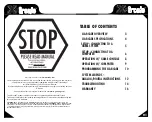
6
BEGIN TO USE YOUR NEW ESC
Before using your new ESC, please check all the connections to make sure that they are reliable, then start up the ESC in the
following sequence:
1. Move the throttle stick to bottom, and then switch on the transmitter.
2. Connect battery pack to ESC, the ESC begin the self-test process, after 2 seconds a long “beep-----“ tone should be emitted,
means self-test is OK, and then the motor begin to play music, now the aircraft/helicopter is ready to go fl ying.
· If nothing is happened, please check the battery pack and all the connections;
· If a special tone "56721" is emitted after 2 beep tone (beep-beep-), means the ESC has entered the programming mode, i.e. the
throttle channel of your transmitter is reversed, please set it correctly;
· If a very rapid “beep-beep-, beep-beep-” tone is emitted, means the input voltage is too high or too low, please check your
battery.
3. After the motor begin to play music, several “beep-”tone should be emitted, present the setting value of each program item. You
can move throttle stick upwards to go fl ying at this time. It is unnecessary to wait the “beep-”tone fi nished.
“VERY IMPORTANT!”
Different transmitter has different throttle range, we strongly suggest you using the “Throttle Range Setting
Function” to calibrate throttle range. Please read the instruction on page 3------“Throttle Range Setting”.
ALERT TONES
1. Input voltage abnormal alert tone:
The ESC begin to check the voltage of battery pack when power on, when the voltage is
not in acceptable range, such a alert tone will be emitted: “beep-beep-, beep-beep-,beep-beep-“( every “beep-beep-” has a time
interval about 1 second. )
2. Throttle signal abnormal alert tone:
When the ESC can’t detect the normal throttle signal, such a alert tone will be emitted:
“beep-,beep-,beep-“( every “beep-” has a time interval about 2 seconds. )
3. Throttle stick not in bottom alert tone:
When the throttle stick is not in bottom (lowest) position, a very rapid alert tone will be
emitted: “beep-,beep-,beep-“ (every “beep-” has a time interval about 0.25 second.)
PROTECTION FUNCTIONS
1. Start up protection:
If the motor failed to start up in 2 seconds while the throttle stick moving up, the ESC will cut off the output
power.
In this case, the throttle stick MUST be moved to bottom again to restart the motor. ( Such a situation happens in the following
cases:
The connection between ESC and motor is not reliable, Propeller is blocked, Gearbox is damaged, etc.)
2. Over-heat protection:
When the temperature of control circuit PCB is over 110°C, the ESC will reduce the output power.
3. Throttle signal lost protection:
The ESC will reduce output power if throttle signal lost for 1 second, further lost for 2 seconds
will cause its output cut off.
SPECIAL HINT
Some high KV out-rotor motors have very special confi guration, the space between each alnico is very large, and some ESC can’t
startup these motors. After program updating, our ESCs have very good compatibility with these motors. But some RC fans still
have several questions about the programming value for special motors. So we just give some suggestion as follows:
Programming value suggestion
Motors types
Timing
Startup Mode
General inrunner motors
Low
Aircraft use “normal” startup mode
General outrunner motors
Medium/High
Hélicopter use “super soft” startup mode
5. Startup mode:
normal / soft / super-soft, default is normal startup.
Normal is good for fi xed-wing aircraft. Soft / super-soft are good for helicopters. The initial speeds of soft / super-soft mode are
pretty slow ,1sec (soft startup) / 2secs (super-soft startup) from startup to full speed. But if throttle is closed (throttle stick moves to
bottom) and opened again (throttle stick moves up) within 3 seconds after the fi rst startup, the startup will be in normal mode to get
rid of the chances of crash caused by slow throttle response in aerobatic fl y.
6. Timing:
low / medium / high, default is medium timing.
In normal cases, low timing can be used for most motors. But for high effi ciency, we recommend the Low timing for 2 poles motor
and Medium timing for 6 poles and above. For higher speed, High timing could be used.
Attention: High timing could cause problem with some motors. Please test on ground fi rst!
• •


























